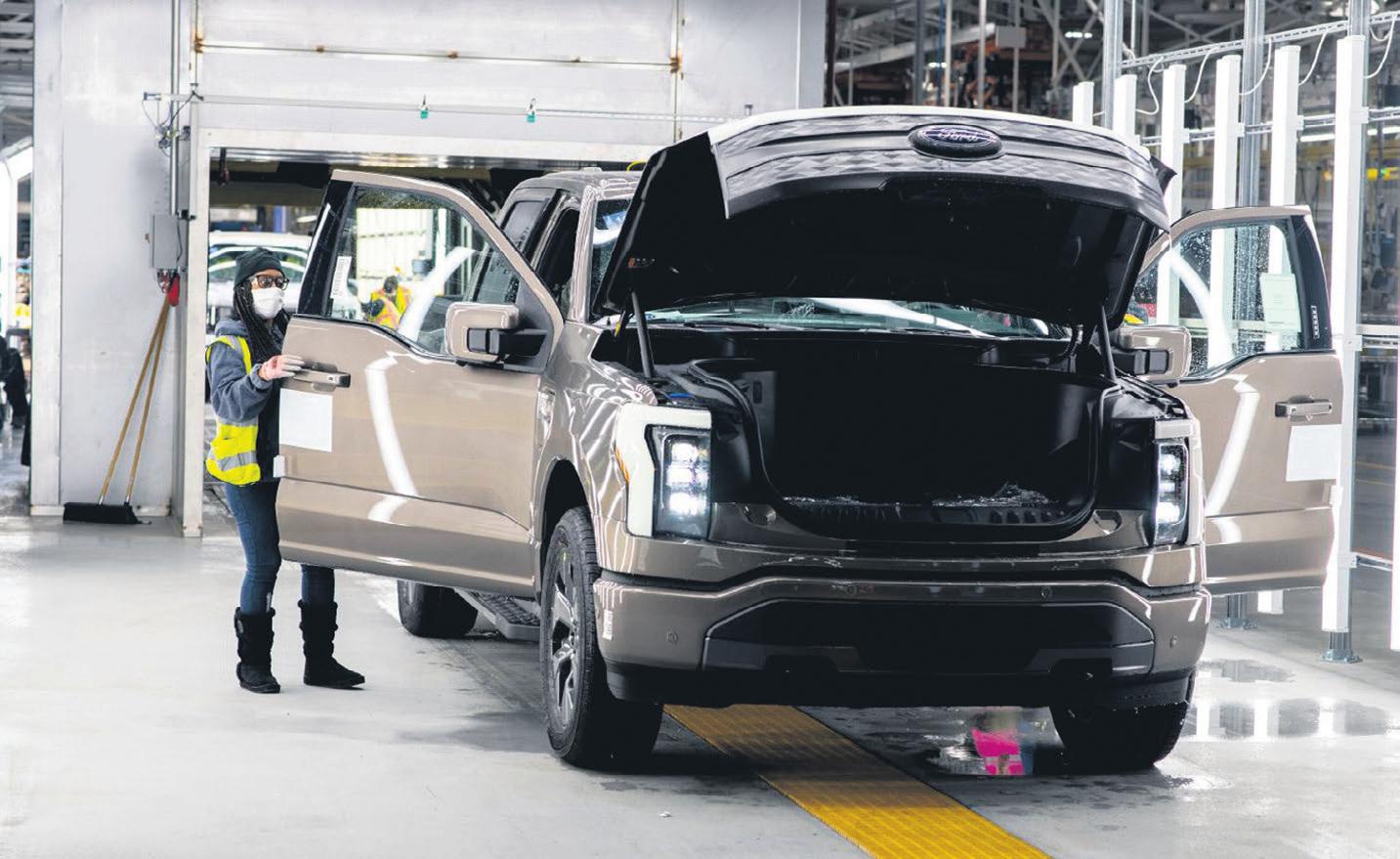
3 minute read
Electric vehicle prices fall as automakers raise production
now available need to be recharged after traveling 200 to 250 miles. Uncertainty about finding charging stations and how long it takes to charge the vehicles can put off some people.
Sales have become particularly sluggish for high-priced luxury models — a segment of the market that has a surfeit of options from the likes of Tesla, Mercedes-Benz, BMW, Porsche and Lucid Motors. Many of these cars cost $75,000 to $160,000.
Advertisement
“I think there was a lot of hype about EVs, and people did their research and realized these are premium vehicles and they’re not cheap,” said Rick Ricart, president of Ricart Automotive, which owns nine new-car franchises in Dublin, Ohio. “And there’s been some pullback.”
Ricart said his family’s Ford store had a top-of-the-line F-150 Lightning Platinum truck on sale for $92,000 for more than two months. “A year ago, it would have been sold by now,” he said.
Another group of electric vehicles that are struggling to find buyers are those that no longer qualify for a $7,500 federal tax credit under the Inflation Reduction Act, President Joe Biden’s ambitious climate change law. The credit is available only on cars that are assembled in North America and that include a certain percentage of battery materials from the region or from U.S. trade partners.
By NEAL E. BOUDETTE
After struggling to find enough batteries and other parts for the past couple of years, automakers are finally beginning to churn out large numbers of electric cars and trucks. More than 30 new models will arrive in showrooms this year.
What they need now are more customers.
While sales of electric vehicles are increasing — they climbed about 48% in the second quarter from a year earlier — they are not rising fast enough to keep pace with the number of vehicles rolling off assembly lines. And inventories of unsold vehicles are starting to pile up.
More than 90,000 battery-powered cars and trucks are sitting on dealer lots, four times as many as a year ago, according to Cox Automotive, a market research firm. That’s enough to last 103 days at the current rate of sales, compared with about 50 days for the industry as a whole.
Manufacturers “are having a ‘Field of Dreams’ moment,” said Jonathan Gregory, a senior manager of economic and industry insight at Cox. “They have built EV inventory, but now they wait for buyers to come.”
In view of this unbalanced supply and demand, automakers are cutting prices and offering more incentives. On Monday, Ford Motor Co. reduced prices of its F-150 Lightning electric pickup truck by $6,000 to nearly $10,000, or as much as 17% on some versions. The company is also offering discounted interest rates of 1.9% to 3.9% on certain loans for Lightning purchases.
These moves follow several rounds of price cuts by Tesla, the dominant seller of electric cars. Tesla’s price reductions earlier prompted Ford to lower prices of its Mustang Mach-E electric sport utility vehicle, although that hasn’t brought Mach-E inventory back in line with sales.
At the end of June, Ford dealers had 16,400 of that model in stock — about 2,000 more than they sold in the first six months of the year.
While many consumers express interest in electric vehicles, they are often not ready to go through with a purchase. Many people have been put off by high prices of electric cars and are waiting for them to cost no more than comparable gasoline models — something that could be hastened by recent price cuts.
Other car buyers have concerns about how far these cars and trucks can travel on a full charge. Many models
In addition to those restrictions, electric sedans have to sell for $55,000 or less to be eligible for credits, and SUVs, pickup trucks and vans have to sell for $80,000 or less.
Purchases of Ford’s Lightning trucks can make buyers eligible for the $7,500 credit, and the company is planning to sell a lot more of the pickups in the coming months. The company temporarily halted production this year to upgrade its assembly line and increase output. By the fall, the company expects its Rouge Electric Vehicle Center near Detroit to be able to churn out 150,000 Lightnings a year, triple its current production capacity.
The company’s decision to lower prices may also have something to do with the growing competition in the electric vehicle business. Tesla said Saturday that it had started producing its much-delayed Cybertruck pickup, and General Motors is expected to soon begin delivering an electric version of the Chevrolet Silverado truck.
Ford’s decision to cut prices unnerved investors who feared it would hurt profits, and its stock price fell 6% on Monday.
Ford said the Pro model of the F-150 Lightning now had a list price of $49,995, a reduction of $9,979. The XLT 312A model with an extended range battery was cut $8,879, to $69,995. The top-of-the-line Platinum extended-range model will sell for $91,995, or $6,079 less than its price last week.
As a result of price cuts, most Lightning models will cost less than $80,000, making them eligible for the $7,500 federal tax credit.










